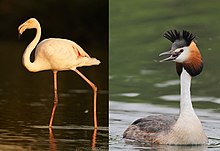Mirandornithes
| Mirandornithes | |
|---|---|

| |
| Greater flamingo(Phoenicopterus roseus) andgreat crested grebe(Podiceps cristatus) | |
| Scientific classification | |
| Domain: | Eukaryota |
| Kingdom: | Animalia |
| Phylum: | Chordata |
| Class: | Aves |
| Clade: | Neoaves |
| Clade: | Mirandornithes Sangster, 2005 |
| Subclades | |
| Synonyms[3] | |
| |
Mirandornithes[4](/mɪˌrændɔːrˈnɪθiːz/) is acladethat consists offlamingosandgrebes.Many scholars use the termPhoenicopterimorphaefor the superorder containing flamingoes and grebes.[5][6]
Determining the relationships of both groups has been problematic. Flamingos had been placed with numerous branches withinNeognathae,such asducksandstorks.The grebes had been placed with theloons.However more recent genomic studies have confirmed these two branches as sister groups.[6][7][8][9][10][11][12]
Both primitivephoenicopteriformesand their closest relatives, thegrebes,were highly aquatic.[13]This indicates that the entire mirandornithe group evolved from aquatic, probably swimming ancestors.[9]
Etymology
[edit]The term was coined by Sangster in 2005, in order to properly describe the new clade discovered with molecular analyses. It is inspired by the Latinmiranda,meaning "wonderful", and the Greek ὄρνις (órnis), meaning bird.[4]
Synapomorphies
[edit]According to Mayr (2004) and Sangster (2005) there are at least twelve distinct morphologicalsynapomorphiesthat are unique to this clade:[4]
- "At least the fourth to seventh cervical vertebrae strongly elongate, with processus spinosus forming a marked ridge.
- Humerus with a marked oval depression at insertion site of musculus scapulohumeralis cranialis.
- At least 23 presacral vertebrae.
- At least four thoracic vertebrae fused to a notarium.
- Distal end of ulna with marked oval depression radialis.
- Phalanx proximalis digiti majoris very elongate and narrow craniocaudally.
- Distal rim of condylus medialis of tibiotarsus distinctly notched.
- Pars acetabularis of musculus iliotibialis lateralis absent.
- Pars caudalis of musculus caudofemoralis absent.
- Wing with 12 primaries
- Left arteria carotis reduced or absent.
- Eggs covered with a chalky layer of amorphouscalcium phosphate."
References
[edit]- ^Švec, P. 1982. Two new species of diving birds from the lower Miocene of Czechoslovakia. Časopis pro mineralogii a geologii, 27, 243–260.
- ^Kuhl., H.; Frankl-Vilches, C.; Bakker, A.; Mayr, G.; Nikolaus, G.; Boerno, S. T.; Klages, S.; Timmermann, B.; Gahr, M. (2020)."An unbiased molecular approach using 3'UTRs resolves the avian family-level tree of life".Molecular Biology and Evolution.38:108–127.doi:10.1093/molbev/msaa191.PMC7783168.PMID32781465.
- ^Sangster, G.; Braun, E.L.; Johansson, U.S.; Kimball, R.T.; Mayr, G.; Suh, A. (2022)."Phylogenetic definitions for 25 higher-level clade names of birds".Avian Research.13:100027.Bibcode:2022AvRes..1300027S.doi:10.1016/j.avrs.2022.100027.
- ^abcSangster, G. (July 2005). "A name for the flamingo-grebe clade".Ibis.147(3): 612–615.doi:10.1111/j.1474-919x.2005.00432.x.
- ^Joel Cracraft;et al. (12 December 2014)."Justifications of names for higher taxa".Science.346(6215): 1320–1331.Bibcode:2014Sci...346.1320J.doi:10.1126/science.1253451.hdl:10072/67425.PMC4405904.PMID25504713.
- ^abJarvis, E.D.; et al. (12 December 2014)."Whole-genome analyses resolve early branches in the tree of life of modern birds".Science.346(6215): 1320–1331.Bibcode:2014Sci...346.1320J.doi:10.1126/science.1253451.PMC4405904.PMID25504713.
- ^Tuinen, Van; Butvill, M.; Kirsch, D.B.; Hedges, S.B. (7 July 2001)."Convergence and divergence in the evolution of aquatic birds".Proc. R. Soc. B.268(1474): 1345–1350.doi:10.1098/rspb.2001.1679.PMC1088747.PMID11429133.
- ^Chubb, A.L. (January 2004). "New nuclear evidence for the oldest divergence among neognath birds: The phylogenetic utility of ZENK (i)".Molecular Phylogenetics and Evolution.30(1): 140–151.doi:10.1016/S1055-7903(03)00159-3.PMID15022765.
- ^abMayr, G. (February 2004)."Morphological evidence for sister group relationship between flamingos (Aves: Phoenicopteridae) and grebes (Podicipedidae)".Zoological Journal of the Linnean Society.140(2): 157–169.doi:10.1111/j.1096-3642.2003.00094.x.
- ^Fain, M.G. Houde (November 2004). "Parallel radiations in the primary clades of birds".Evolution.58(11): 2558–2573.doi:10.1554/04-235.PMID15612298.S2CID1296408.
- ^Ericson, J.I.; Anderson, P.G.P.; Britton, C.L.; Elzanowski, T.; Johansson, A.; Kllersj, U.S.; Ohlson, M.; Parsons, T.J. (22 December 2006)."Diversification of Neoaves: integration of molecular sequence data and fossils".Biology Letters.2(4): 543–547.doi:10.1098/rsbl.2006.0523.PMC1834003.PMID17148284.
- ^Hackett, S.J.; et al. (27 June 2008). "A phylogenomic study of birds reveals their evolutionary history".Science.320(5884): 1763–1768.Bibcode:2008Sci...320.1763H.doi:10.1126/science.1157704.PMID18583609.S2CID6472805.
- ^Mayr, G. (2014) The EoceneJuncitarsus– its phylogenetic position and significance for the evolution and higher-level affinities of flamingos and grebes.Comptes Rendus Palevol.13(1):9-18.https://doi.org/10.1016/j.crpv.2013.07.005


